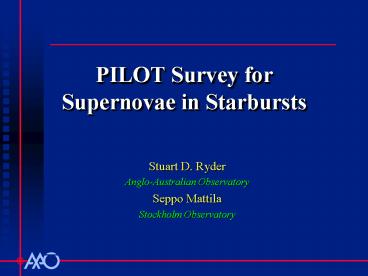PILOT Survey for Supernovae in Starbursts - PowerPoint PPT Presentation
1 / 7
Title:
PILOT Survey for Supernovae in Starbursts
Description:
Core-collapse SNe (CCSNe) generate/liberate the bulk of the ... Can serve as probes of extinction and ISM. CCSNe blast wave probes progenitor mass-loss history. ... – PowerPoint PPT presentation
Number of Views:15
Avg rating:3.0/5.0
Title: PILOT Survey for Supernovae in Starbursts
1
PILOT Survey forSupernovae in Starbursts
- Stuart D. Ryder
- Anglo-Australian Observatory
- Seppo Mattila
- Stockholm Observatory
2
Why Supernovae?
- Core-collapse SNe (CCSNe) generate/liberate the
bulk of the light metals. - CCSNe directly trace recent massive SFR (cf. UV,
Ha, FIR, radio, Fe II, ) - Can serve as probes of extinction and ISM.
- CCSNe blast wave probes progenitor mass-loss
history.
3
Why Starbursts?
- Supernova Factories ULIRGs (LIR gt 1012 L?)
have SFRs gt 100 M? yr -1, so gt 1 CCSN yr -1. - High Z ? high MLR, may influence SN evolution.
- ULIRGs/starburst galaxy nuclei are crowded,
heavily-extincted (AV gt 10) regions ? NIR, radio. - NIR allows follow-up at much earlier epochs not
all CCSNe are radio-loud. - WHTINGRID/LIRIS K-band monitoring of 40 nearby
(D lt 45 Mpc) non-AGN starbursts. - VLTNACO monitoring of 14 ULIRGs out to
D 300 Mpc.
4
Historical SN in NGC 7714
- Found in archival UKIRT K image from Sep 1998.
- Optimal Image Subtraction (Allard Lupton 1998).
- lt 1 kpc from nucleus.
- Not seen in U, J, H ? AV gt 6.
5
AO on ULIRGs
- Require Strehl ratios 0.2 0.3 to yield 0.06"
(100 pc) resolution _at_ 300 Mpc. - NACO currently delivers (time variable) SR 0.1
when guiding on ULIRG nucleus.
NICMOS 1"
IRAS 23128-5919 IRAS 17208-0014
6
Discovery rate
- Assume
- Stable, near diffraction-limited (0.3") PSF over
FOV of InSb array (0.23" pix-1). - 10 min exposures ? 10s for K22.5.
- Monitor 15 ULIRGs out to 150 Mpc.
- Detectable fraction increases with nuclear
distance out to 500 pc. - M82 SNR extinction distribution (AV 24, s 9).
- Template light curves for ordinary (MK 18.6)
and slowly declining (MK 20.0) CCSNe.
7
Summary
- Expect
- 46 CCSNe (for 530 slow-decliners) by observing
sample annually - 9 CCSNe per year by observing each galaxy 3
times - More frequent monitoring ? light curves.
- PILOT would deliver comparable CCSNe discovery
rates to AO ULIRG survey on 8m, or nearby
starburst survey with 4m telescopes.































